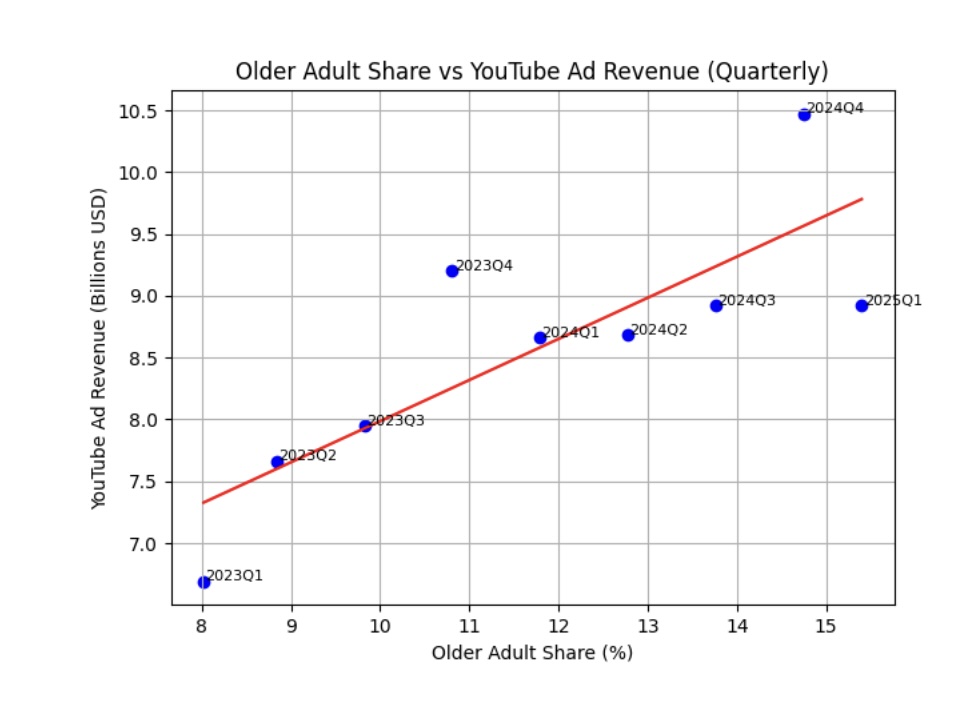A demographic shift in viewership
With the rise of streaming, one platform is surging to prominence. According to Nielsen’s March 2025 report, YouTube now commands the highest total TV usage share of any media company at 11.6 percent. This marks a 53 percent increase in viewership compared to two years ago. But it is not because of younger generations sensationalized “addiction” with phones. It is a surge driven largely by older adults. In 2023, viewers aged sixty-five plus represented just 7.89 percent of YouTube’s audience. But by 2025, that more than doubled to 15.4 percent, more than any other consumer base. For Alphabet, YouTube’s parent company, capitalizing on this gray wave with ad revenues could be their key to greater expansion.
But what influence has this cohort really had? One way to uncover this is by looking into YouTube revenues, specifically, their ad revenue. As more people watch videos, YouTube profits off the ads embedded around these videos. My regression analysis of Alphabet’s quarterly earnings from 2023 to 2025, using an interpolated linear trend between the February 2023 and February 2025 viewership shares for adults sixty-five and older reported by Nielsen, shows a clear positive relationship between this group’s share of the overall audience and YouTube’s ad revenue. For every 1 percent increase in the proportion of YouTube’s total viewership accounted for by adults sixty-five and older, the platform’s ad revenue has risen by roughly $0.33 billion. While the correlation is not strong enough to claim that older adults are the sole driver of revenue growth, the trend is unmistakable: as their share of viewership rises, so does YouTube’s income. Now correlation does not mean causation; there are multiple factors accounting for YouTube’s rising revenue including the use of AI targeting, new product verticals like YouTube shopping, TV and sports/media rights, expanding creator economy, subscriptions, and advertising overall. What this does mean is that if older adults are claiming a larger slice of the audience, YouTube will inevitably seek to monetize that shift to keep revenues high. This group is taking over the platform faster than any other demographic, and YouTube is likely to capitalize on this surge. The question, however, is whether the platform’s push to capture this audience will repeat the same cycle of harm we have already seen with younger viewers’ mental health.

How YouTube hooks and profits from older adults
YouTube effectively capitalizes on the psychology of older users through three phases of usability: lowering barriers to entry, fostering long-term retention, and enriching experiences through augmented experiences.
Older adults consistently point to usability and ease of engagement as key factors when interacting with digital platforms. YouTube stands out because its interface is intuitive, requiring little technical literacy, and its short-form videos lower the barrier to entry regardless of education level or prior digital experience. Studies highlight that the platform’s visually driven design, clickable content tiles and video-first layouts, makes navigation simple, and familiarity grows quickly with repeated exposure.
Once older adults are engaged, YouTube often meets their emotional and social needs. Vlogs and familiar creators foster a sense of connection, tutorials and lectures allow learning at one’s own pace, and nostalgia-driven recommendations keep users coming back. This cycle of engagement is amplified by YouTube’s personalized algorithms, which surface more relevant content over time. The result is not only longer viewing sessions but also greater ease navigating the platform itself.
Beyond its core video library, YouTube has also adopted augmented experiences to deepen engagement. Augmented reality features, such as ticketed live events or integrated product sales, create viewing experience beyond simply watching videos. These experiences blend entertainment with interaction, offering older adults both connection and novelty, while simultaneously advancing YouTube’s monetization strategy.
Older adults’ viewing habits are a boon for YouTube’s ad business. Because they are less likely to switch platforms mid-session, they tend to watch for longer stretches, increasing the number of ad impressions served. YouTube’s revenue model gives the platform a 45 percent cut of ad income, with the remainder going to creators.
So how do these ads work? Companies pay YouTube either upfront or every time someone sees the ad. These companies set targeting criteria to reach specific populations and outline a budget for how much they are willing to spend per view or click. The platform does not typically profit from whether viewers buy the product, unless there are special affiliate partnerships in place. Instead, YouTube works their magic and earns money simply by showing the ad.
The risk and benefits of overload
But is this revenue growth coming at the cost of vulnerable populations? Research on short-video platforms has shown that older adults can be vulnerable to “information cocoons,” where algorithms repeatedly serve similar content. This can lead to “short-video overload,” in which prolonged viewing displaces real-world social interaction, increasing loneliness and depression. Adults with lower self-discipline are particularly at risk, and when they feel overloaded, even strong values like respect and reflection cannot fully mitigate the negative emotional effects.
Importantly, the same study suggests that when video overload is managed, older adults can experience significant benefits as well. Thoughtfully curated short-form content can enhance leisure activities, improve mental health, and foster intergenerational connections. For example, sharing and discussing videos with younger family members can bridge generational divides. Augmented experiences, when used to complement offline engagement, can help combat isolation, promote physical activity, and increase life satisfaction.
Alphabet’s balancing act
Older adults represent a stable, growing segment of YouTube’s audience at a time when Alphabet’s core businesses like search and cloud are no longer expanding at their historic rates. Their loyalty, consistent viewing patterns, and high watch times make them a valuable source of predictable ad revenue. But the same engagement that boosts Alphabet’s bottom line can also create risks for user well-being if the platform focuses solely on maximizing watch time.
The gray wave on YouTube is a reminder that technology adoption is not just a youth trend. It is also a test case for whether a global platform can balance profit with responsibility. For Alphabet, the challenge is clear: sustain the revenue older adults help generate without undermining their mental health in the process.
Adwait Chafale is a medical student.

















![A pediatrician explains the real danger of food perfectionism [PODCAST]](https://kevinmd.com/wp-content/uploads/The-Podcast-by-KevinMD-WideScreen-3000-px-4-190x100.jpg)
![Rebuilding the backbone of health care [PODCAST]](https://kevinmd.com/wp-content/uploads/Design-3-190x100.jpg)

![A psychiatrist explains the new frontier of prescribed software treatments [PODCAST]](https://kevinmd.com/wp-content/uploads/Design-4-190x100.jpg)
